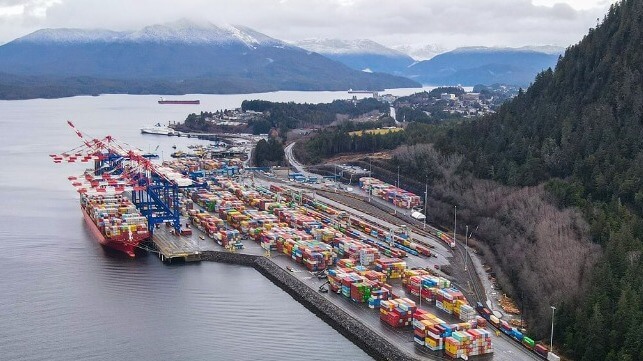Canada’s Prince Rupert Starts Build for New Rail-to-Container Terminal

The Port of Prince Rupert, already one of the largest in Canada and a significant part of the country’s exports to Asia, is commencing construction of a new large-scale logistics project that they report will provide expanded capacity and capabilities for rail-to-container transloading of multiple export products. The port authority expects the new facility known as the Ridley Island Export Logistics Project will result in stronger volumes for loaded export containers moving through the Port of Prince Rupert and a more sustainable balance in its intermodal import and export trade.
Canadian logistics company Ray-Mont currently operates a multi-product transload facility on a temporary Ridley Island location. Port executives report that the facility has proven the export transload concept in Prince Rupert and they look forward to building on this operation.
They expect to invest C$750 million (US$550 million) in the project, which will consist of a 108-acre greenfield development on Ridley Island, located south of the city. They expect the new facility will commence operation in the third quarter of 2026. Ray-Mont Logistics will develop and operate facilities that provide transloading service capacity for 400,000 TEUs for agricultural, forestry, and plastic resin products.
The project will also include an expansion of the existing Ridley Island Road Rail Utility Corridor that will facilitate unit trains 10,000 feet in length with direct access to the site from the CN network. The transload facilities will be connected to Fairview Container Terminal by direct private road access. In addition, taking steps forward in decarbonization the plan calls for the full electrification of the transload facilities, optimization of rail, and minimal truck drayage.

The new facility will be located on a greenfield location on Ridley Island (Port Authority of Prince Rupert)

that matters most
Get the latest maritime news delivered to your inbox daily.
Port officials highlight that the new facility will provide innovative capacities for Canadian exporters to Asia Pacific markets. The project’s large scale, unit train capabilities, access to available empty containers, and proximity and integration into container terminal operations they report will make it a unique model with the ability to deliver significant new service offerings to exporters that will greatly improve the quality, cost, and reliability of container supply chains.
Prince Rupert is already a major gateway port for Canada, handling nearly 18 million tonnes of foreign cargo in the first nine months of 2023. It has diverse operations with a container terminal, which it promotes as the continent’s first purpose-built ship-to-rail container terminal, as well as bulk, gain, and wood pellet terminals. They also cite its advantages of being the deepest North American port and its location gives it the shortest route to Asia. They expect the new terminal will build on the already extensive rail access across Canada and into the U.S. Midwest to expand trade passing through the port.
